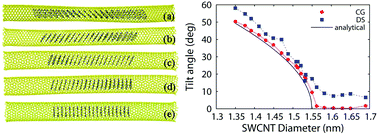Geometrical constraint on stacking of polycyclic aromatic hydrocarbon molecules encapsulated in a single-walled carbon nanotube
Abstract
The stacking morphologies of polycyclic aromatic hydrocarbon (PAH) molecules encapsulated in a single-walled carbon nanotube (SWCNT) are investigated by using a molecular-dynamics (MD) method. The encapsulating SWCNTs are of twenty different diameters. For coronene molecules, both conjugate-gradient (CG) energy minimization of the stacked molecules in a SWCNT and dynamics simulation (DS) of encapsulation of the molecules in a SWCNT are performed; while for sumanene molecules, only DS of encapsulation of the molecules in a SWCNT is performed. The tilt angles and intermolecular distances are calculated from the final configurations via CG and DS. On the assumption that the morphologies of the molecules in a SWCNT are determined by the geometrical constraint condition, semi-analytical formulas for the dependence of the tilt angles of the molecules on the SWCNT diameter are derived. These formulas are expressed in terms of the inverse functions of cosine the arguments of which are linear functions of the SWCNT diameter, and successfully agree with the simulation data. Accordingly, they are useful for controlling the tilt angles of the PAH molecules encapsulated in a SWCNT by adjusting the SWCNT diameter. It is also revealed that the stacking geometry of sumanene molecules with small tilt angles in a SWCNT is consistent with that of a sumanene dimer in a free space which Karunarathna and Saebo (Struct. Chem., 2014, 25, 1831) obtained using ab-initio calculations.



 Please wait while we load your content...
Please wait while we load your content...